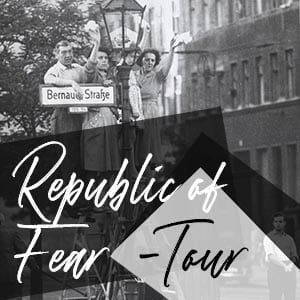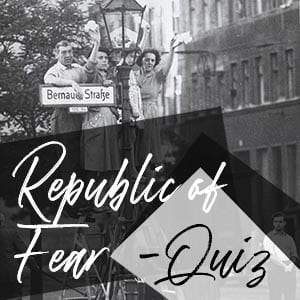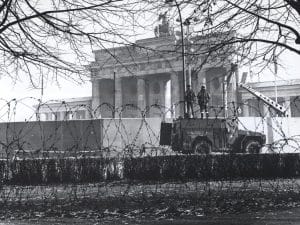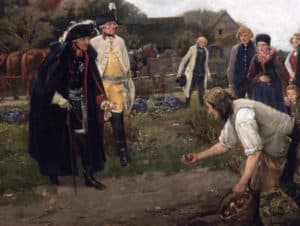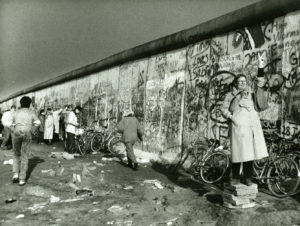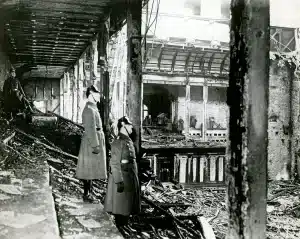“Freedom has many difficulties and democracy is not perfect, but we have never had to put a wall up to keep our people in, to prevent them from leaving us.”
John F. Kennedy
Who, exactly, built the Berlin Wall?
Who were the workers who accomplished this staggering task? But more appropriately – and often the actual point of inquisition – who was responsible for the decision to construct the Berlin Wall? Which state, power, or person/s?
Of course, equally, if not more importantly, hidden within the innocuous phrasing of the question – why?
Humans have constructed walls for thousands of years, from the ancient examples in Mesopotamia and Babylon, through the towering achievements (and failures) of Constantinople and the Great Wall of China; to modern day gated communities and the contemporary mania for security fences and fortified borders. These walls have largely served one purpose- to keep outsiders at bay and establish a domain of absolute security.
The Berlin Wall, however, from its conception, was a different kind of barrier.
As David Fyre, author of ‘Walls – A History of Civilisation’, explains: “It is the universal example, perpetually at hand, perpetually tossed into discussions of barriers with which it had absolutely nothing in common. In its afterlife, it has assumed an importance out of proportion with its reality.”
Fyre is describing the regularity with which this particular example is trotted out and displayed as the ultimate indication of the failure of walls. His argument being that rather than symbols of oppression and the failure of humanity; these barriers have stood for millennia as representations of the success of humanity, guarantors of civilisation, and ensured the peacetime conditions essential for prosperity.
An opinion that was not far from the minds of the people responsible for the construction of the Berlin Wall in 1961 – even if the story would not play out that way.
–

What Was The Berlin Wall?
“The builders in our capital are engaged in residential construction, and its labourers are deployed for that. Nobody has any intention to erect a wall.”
Walter Ulbricht, East German leader, June 1961
Legend has it that when biblical King Solomon was asked to mediate over a maternity dispute, he set out to resolve the situation by ordering the baby split in half. Only at the last minute intervening to award the child to the woman who objected most.
Although not lacking in drama, the division of the former Nazi capital of Berlin in 1945 – into four distinct zones, awarded to each of the four victorious Allies – would not prove so easy to conclude.
In-fact this impossible design, where fairweather wartime allies were expected to come to terms as peacetime partners, would all but guarantee friction between these four powers.
The resulting formation of the Federal Republic of German (FRG) and German Democratic Republic (GDR), from the respective British, French, American – and Soviet zones of occupied Germany – only further served to illustrate the irreparable differences, particularly between the capitalist West and socialist East. As West Germany rose to prominence as the ‘shop front window of the Western world’, the East began to falter; lagging behind in the availability of consumer goods and imposing on the population the hallmarks of the Soviet system; collectivisation, industrialisation, and work quotas. Marxist-Leninist dogma, and dedication to the international class struggle would underpin the actions of the state at every turn.
The enclave of West Berlin, inside the borders of East Germany, divided in almost identical fashion to the occupation sectors of the entire country, would prove to be an unusual threat to the success of the socialist GDR. With the combined French-British-American sector of the city growing to become a ‘thorn in the side’ of the East German state, while serving as a beacon of hope for the country’s beleaguered population.
Soviet premier, Nikita Krushchev, would alternately refer to this aberration as ‘a bone in his throat’ or ‘the testicles of the West’. By its mere existence, West Berlin threatened the socialist East by offering a glittering alternative to the dour reality of the international class struggle. But it would also prove useful to the Soviets whenever the need to antagonise the West came up, as an isolated island of capitalism within the borders of East Germany was such a readily available target – constantly threatened with the overwhelming force of the Soviet troops stationed around it.

When discussing the whirlwind of this East-West ideological confrontation, it can easily be overlooked that there were many living in the East who were genuinely content with their lot and, not only eager to move past the uncertainty of the conflict-ridden past, but turn a blind eye to some of the more egregious and repressive actions of the state.
Some saw the advantage in taking advantage of both adjacent systems. Many East Berliners would take the opportunity to cross into the West and indulge in the benefits of this island part of the federal democratic state: about one third of the 15,000 students at the Frei Universität in West Berlin were East Berlin residents before the construction of the Wall.
But to plenty of East Germans, unhappy with the state of society, and Soviet attempts to engineer a planned economy and socialist utopia, West Berlin in particular would serve as a gateway to a new life in the West. While East German freedom of movement had been restricted in 1952, with the construction of the ‘Inner German Border’ as part of the ‘Iron Curtain’ – a physical barrier separating East and West that ran from the Baltic sea south through Europe – it was still possible to get to West Berlin, at a time when access to Western Europe was restricted.
A move that plenty of East Germans chose to make.
An expansion in the West German economy and corresponding decline in its labour reserves would cushion this growing number of refugees fleeing from the East to the capitalist foe in the 1950s – with West Berlin serving as the chief escape route.
Four years after the founding of East Germany, the people in the country would experience an event that would shape the destiny of the country for the next four decades – and increase the number of citizens eager for sanctuary elsewhere. Following the death of Soviet leader, Joseph Stalin, the East German government chose to increase work quotas by 10% and accelerate progress towards true Socialism – causing workers throughout the country to revolt in protest on the 16th and 17th June 1953.
This uprising – similar to what would happen in Poznan, Poland at the same time, and followed in Hungary in 1956, and Czechoslovakia in 1968 – would be a visible display of the growing disconnect between the people of the country and the ideas of the state.
Subsequently treated as the ‘Tiananmen Square moment’ in East German history books, any trace of this ‘peoples’ uprising’ would be erased from the official version of events, along with the images of the Soviet tanks that would be brought in to crush the rebellion. Instead this confrontation would be portrayed as the West fomenting dissent within the country and the swift action of the state, the perfect example of the resolve of the Socialist brotherhood to deal a blow to the Imperialist foe.
The result would be that many more, now recognisably disenfranchised, East Germans would instead choose to vote with their feet. Moving West as refugees.

Between 1945 and 1961, up to 3.5 million East Germans would flee to the West – openly challenging the East German ruling party’s claim to popular approval.
The act of fleeing the country as part of this exodus would acquire an official name in the GDR: “Republikflucht” (Fleeing the Republic).
Not only was this an acute embarrassment to communist pretensions, this exodus would come to undermine the Eastern German economy – and threaten the continued existence of the country.
To put a stop to this march West, the East German government would resort to a desperate final measure in 1961. Surrounding the French-British-American sectors of West Berlin with barbed wire fences, overnight. Contrary to popular belief, this barrier did not simply stand between East and West Berlin; but completely surrounded West Berlin – at over 155km long.
The first version of the Berlin Wall.
East German leader, Walter Ulbricht, would issue a special statement, released in the early hours of August 13th 1961, explaining the solidification of this frontier as a result of the actions of the West. Blaming “revenge seeking and militaristic forces” for their “systematic plans for a civil war”.
He would state that the “sole purpose” of the border closure was to provide security for the East German people and remedy the threatening behaviour of these nefarious forces.
To Soviet leader, Nikita Krushchev, this was to be “a necessary and only temporary defect.” Whilst remaining privately frustrated that Ulbricht had not managed to resolve the situation and counteract the exodus by tapping “the moral and material potential that would someday be harnessed by the dictatorship of the working classes.”
For ten days, West Berliners would not be allowed access to East Berlin; that would eventually change.
From August 13th 1961, however, East Germans would not be allowed to visit the West without special passes issued by the Interior Ministry.
Which would be near impossible to acquire.
–
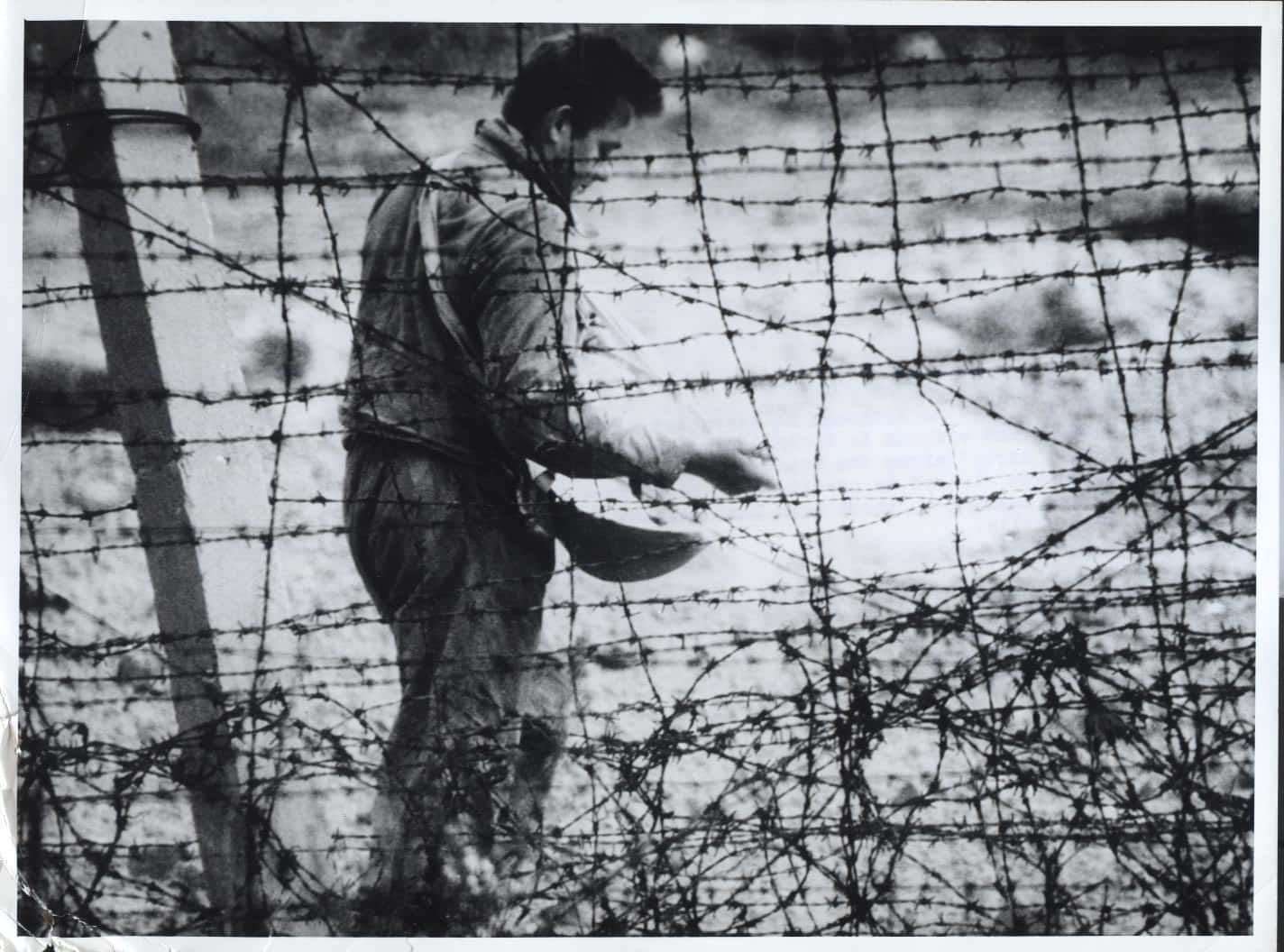
When Was The Berlin Wall Built?
“Up to August 13th 1961, the East Berliners were half free. They had, of course, to work during the day… and were subject to an arbitrary legal system. But in the evening at the close of work, they came over to West Berlin to meet relatives and acquaintances, go to the movies or the theatre, stroll up the Kurfiirstendamm [shopping boulevard], read Western newspapers… Some 200,000 Germans from East Berlin and the Soviet zone visited West Berlin every day. Berlin, despite political division, was still a special area.”
Otto Frei, Swiss writer, on Berlin before the Berlin Wall, 1963
When constructed in August 1961, the Berlin Wall was known by a different name – the Anti-Fascist Protection Rampart (Antifaschistischer Schutzwall) – officially credited with protecting the people of the German Democratic Republic from the Imperialist (and Fascist) forces of the West.
While commonly used to refer to this historically significant stretch of concrete, the term – the Berlin Wall – was not actually the official name of this object. In-fact, use of the term today still implies a particular perspective that many visitors to the city would be completely unaware of.
The perspective of the West.
Looking towards a frontier that remained closed for 28 years, 3 months, and 28 days.
And the concrete barrier that came to represent the failures of the East German state and its Marxist-Leninist doctrine.
However, when the first section of ‘the Berlin Wall’ was constructed on the Sunday morning of August 13th 1961, it was not actually a wall – but a barbed wire fence. Laid around West Berlin in long sections and connected to concrete stakes driven into the ground – as part of a one-night drama codenamed ‘Operation Rose’.
While the construction of this barrier was without a doubt premeditated, the introduction of it would be a patchwork affair – with washing line posts used to connect barbed wire in places, and residential buildings, cemeteries, and terrain destroyed to clear the way for this symbolic obstacle.
The solid frontier of barbed wire would eventually evolve, to a concrete barrier – and a much greater void inflicted on the city. An inner and outer barrier, with an internal ‘death strip’ filled with obstacles, to better deter anyone intent on fleeing from the East and allow the border guards a wide field of vision to shoot any traitors they might encounter.
The barbed wire required for this initial phase would be bought in bulk from several different manufacturers in West Germany and in Great Britain, as to avoid suspicion whilst planning to envelop West Berlin it was seen as necessary to distribute the acquisition of the quantity needed to a number of innocuous looking East German purchasers, who negotiated the deals directly.
Echoing Vladimir Lenin’s prediction that: “The capitalists will sell us the rope with which we will hang them.” Albeit, with one significant perversion, the rope would be used to suffocate nearly 18 million East Germans.
In planning Operation Rose, East German advisors mapped every inch of the internal border between West and East Berlin (around 45km) and the remaining stretch that separated West Berlin from the countryside of the neighbouring East German state of Brandenburg.
Three weeks before construction of the Berlin Wall frontier began, the East German technocrat and carpenter responsible for the department that oversaw the preparations reported to his superior about the material shortages of necessary supplies. Fifty-six-year-old Bruno Wansierski would be one of the few people in the country familiar with the extent of the project, in his capacity as director of the Department for Security Questions of the Socialist Unity Party’s Central Committee. Not only would this mammoth undertaking require barbed wire, but also concrete pillars, metal cramps, connecting wire, mesh wire, and timber. Trucks from the industrial town of Eisenhüttenstadt near the Polish border had already brought in hundreds of concrete pillars and stockpiled them in a police barracks in the district of Pankow. But the remaining supplies necessary would have to be gathered in secret, as such not to draw the attention of the prying eyes of the West, or give any indication to the people of East Germany of what was to come.
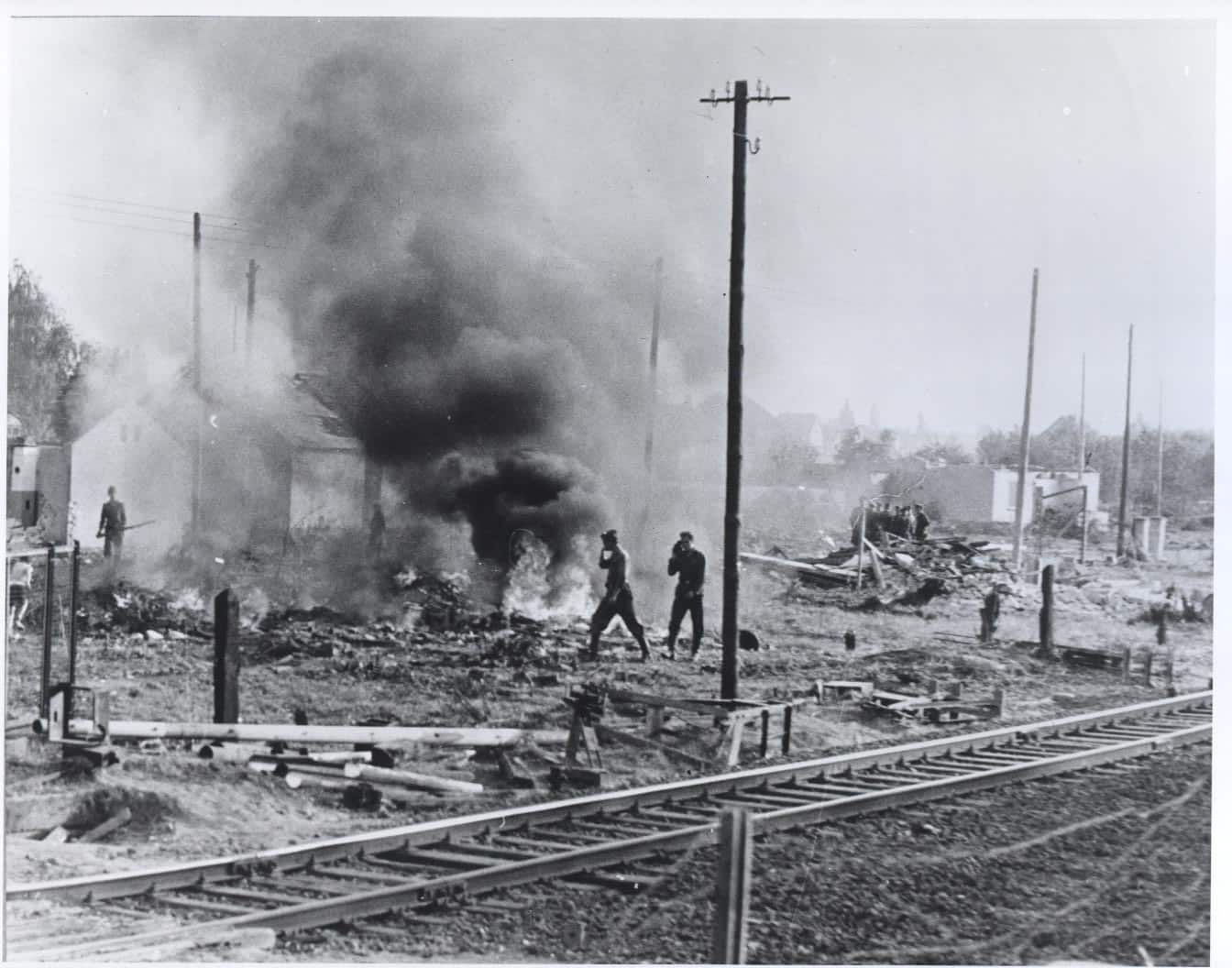
Life in the city on August 12th, the day before the implementation of Operation Rose, continued as on any other typical summer day – with temperatures reaching 24c and light cloud cover providing enough relief to make the day pleasant enough for many in the city to spend time outside. A change from the rain that Berlin had experienced for much of the previous week.
Cafes, parks, and lakes were full of people; while Zimmerstrasse, near the famous Checkpoint Charlie crossing, was closed off for the annual Kinderfest (Children’s fair), the US Commandant in Berlin – unaware of the preparations in the East – spent the day on the golf course of the members-only Blue-White Club.
For much of this sunny Saturday, the Severin and Kühn tour buses shuttled people across the border from the West into the East to explore the Soviet sector.
Berlin Mayor, Willy Brandt, spent the evening campaigning in the south-eastern German city of Nuremberg, as part of the final phase of his national campaign to oust Konrad Adenauer as West German Chancellor. Prophetically he would speak of how East Germans were fearful that the “Iron Curtain will be cemented shut” and they will be “locked in a giant prison” as the Soviet Union was “preparing a strike against our people, the seriousness of which only a very few understand…”
Adenauer, campaigning in Bonn, would take a more conciliatory tone, asking East Germans to stop moving westwards and remain within their own borders to prepare East Germany for reunification.
To the outside eye, the garden party that East German leader, Walter UIbricht, decided to host at his countryside retreat at Grosser Döllnsee the evening of August 12th, some twenty-five miles outside Berlin, would rouse little suspicion – and offer little indication of the coming undertaking.
At 4pm, Ulbricht had given the green light to Security Secretary Erich Honecker to begin Operation Rose. He would appear at the garden party relaxed and surrounded by the crucial players in that evening’s events. Perhaps the only thing that would have seemed amiss on closer inspection was that the property had previously served as a hunting lodge for Nazi Aviation Minister, Hermann Göring.
The guests would remain hermetically sealed in the venue for the night, until the operation was completed.
Soviet leader, Nikita Krushchev, was on his way to the Crimea to prepare for his October Party Congress, and US President, John F Kennedy, spent much of the day trying to beat the heat in Massachusetts by embarking on a four-and-a-half-hour boat trip on Cape Cod.
The Marienfelde refugee centre in West Berlin, the first stop for anyone looking to resettle from East to West, and the twenty-five three-story apartment blocks there were filled to bursting.
West Berlin movie houses were largely sold out too, with many East Berliners travelling across to see the latest hits; The Misfits with Clark Gable and Marilyn Monroe, Ben Hur with Charlton Heston, The Old Man and the Sea with Spencer Tracey, and For Whom The Bell Tolls with Gary Cooper.
While British, French, and American soldiers roamed the city freely, Soviet troops spent the night confined to their barracks.
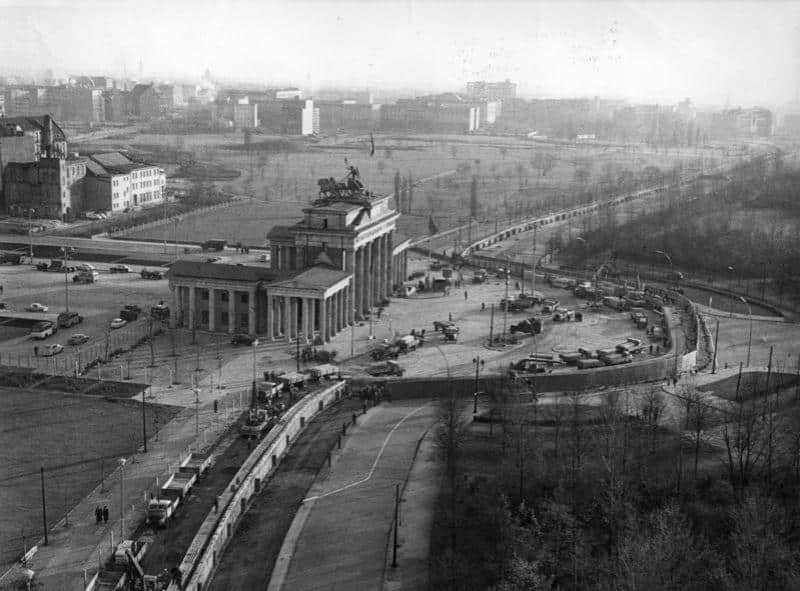
At exactly 1am on August 13th 1961, the streetlights near the East-West border were turned off, allowing the workers involved in the Berlin Wall operation thirty minutes to encircle West Berlin and begin their duties.
Over the next 180 minutes, the first barricades would be erected and sixty-eight of the eighty-one crossing points to West Berlin closed off. That left thirteen checkpoints for the East Berlin authorities to deal with later in the day.
At the same time, public transportation ground to a halt, with teams dispatched to start splitting train tracks, while eight hundred transportation police manned stations to dissuade unrest.
The plan stated that all tasks necessary for securing the border around West Berlin would be completed by 6am.
Sunday August 13th 1961, millions of Berliners awoke to find the city not only divided but West Berlin surrounded with a barbed wire barrier – and thousands of troops patrolling this newly solidified frontier to deter any escapes and stem the flow of refugees flooding into the West.
Not only did West Berlin now stand as an island of Capitalism; but a paradoxical prison. Where the only free people were stuck inside.
Free to leave. Free, soon, to visit the East. Free to rock. Free to roll. Free to vote for various competing political parties, and free, eventually, to cover the blank canvas of what would grow into a monstrous concrete barrier in graffiti and slogans calling for its much overdue removal.
On August 17th, as Berlin registered one of the coldest days of that year’s summer, East German workers began the construction of a breeze-block wall topped with barbed wire fence. Over time this would grow into the object that many recognise today as the Berlin Wall. A barrier that looked more and more permanent by the year – as amendments and further obstacles were made.
Despite this illusion of permanence, just like the mud brick walls of Mesopotamia, the Berlin Wall would eventually be swept away.
It would prove temporary, it would just require decades of patience and politics to see it disappear.
–

Who Built The Berlin Wall?
“What happens to Berlin, happens to Germany; what happens to Germany, happens to Europe…”
Soviet Foreign Minister Vyacheslav Molotov
East German leader, Walter Ulbricht, and Soviet premier, Nikita Krushchev, met during the Second World War under peculiar circumstances – at the battle of Stalingrad. Where Krushchev was tasked with organising the city’s defenses against the Wehrmacht, and Ulbricht, the German Communist in exile, was busy engaged in a propaganda campaign to convince German soldiers to defect.
The question of who was responsible for the order to construct the Berlin Wall is inseparable from the greater question of who really held power in the country, the extent of meddling from Moscow, and the relationship between these two men in 1961.
Shortly after the establishment of East Germany, Soviet leader Joseph Stalin had approached the Western Allies with the suggestion to establish a reunified and neutralised German state – with a document commonly referred to as the Stalin Note that was delivered in 1952 – something which the British, US, and French representatives rejected. Stalin’s successor, Krushchev, would similarly prefer to maintain the status quo of the division of the country; ensuring that East Germany would act as a satellite state of the Soviet Union and an integral part of the Eastern Bloc alliance.
At this time there was no official peace treaty between East Germany and the Soviet Union; but the alignment of the political systems of the East would bring the two closer than close. As East Germany, the former Soviet occupation zone, still remained tied to Moscow by an umbilical cord of thousands of Russian troops stationed in the country.

The order to begin construction of the Berlin Wall on August 13th 1961 would come from Walter Ulbricht, as First Secretary of the ruling Socialist Unity Party in East Germany – but with the connivance and support of Krushchev. Together they would “encircle Berlin with an iron ring…” according to the Soviet leader.
One of the clearest illustrations of this partnership in planning the construction of the Wall was only discovered in 2009 by a historian working at the German Historical Institute in Moscow. A previously unheard of telephone conversation that took place between the two leaders over two hours on August 1st 1961.
The pair discussed the plans to close the border between East and West, which by this time were already in motion. Deliberating about the reasons for the sealing of the border, the timing and some of the difficulties they expected might arise. With Krushchev advising Ulbricht: “You should not explain anything before the introduction of the new border regime… it would only strengthen the flow of people leaving.”
Two days later, on August 3rd 1961, Walter Ulbricht arrived in Moscow for an emergency Warsaw Pact summit and met Krushchev in person to make the final arrangements for the border closure.
It was at this meeting that the two concluded on the date for the operation to begin, with Ulbricht suggesting either the 12th or 13th of August – adding that the number 13 is considered an unlucky number in the West.
Krushchev responded by saying: “For us and for the whole socialist camp it would be a very lucky day indeed.”
Without referring to the details of the Berlin Wall operation, Krushchev asked the Warsaw Pact group to approve the improvement of border controls in East Germany, comparable to those that already exist along the East-West border of the Iron Curtain.
“We propose that the Warsaw Pact states agree, in the interests of the cessation of the subversive activity, to implement control along the GDR borders, including the borders of Berlin, comparable to that existing along the state borders of the Western Powers.” Nikita Krushchev
An important detail that Krushchev was eager to reassert to Ulbricht, that all operations should remain entirely within East German territory and “not a millimeter more” into West Berlin.

The refugee problem needed an immediate solution; but at this time, while both men were busy discussing the timing of the border closure, the extent of fortifications that would eventually exist were not on the agenda. Ulbricht would simply state: “We will erect barriers of barbed wire. The wire has already been assembled. All of this can be done very quickly.”
The timing of the initial phase of the construction of the Berlin Wall would be agreed upon at an extraordinary meeting of the Politburo of the Central Committee of the SED on August 7th 1961.
On August 11th, head of the East German State Security Police, Erich Mielke, met with an enlarged leadership group of the Ministry for State Security and informed them of an upcoming ‘planned measure’, stating: “No enemy is to become active; no mass gatherings are to be allowed… Anyone uttering hostile remarks is to be arrested. Enemies are to be dealt with strictly and with more severity at the present time.”
It was during this meeting that Mielke would give the operation its codename: Operation Rose.
The meticulous planning of this one-night performance would ensure its success. While Krushchev and Ulbricht would officiate the proceedings, 48-year-old Erich Honecker – the East German government’s man in charge of security matters, as Secretary of the National Defence Council, would deal with the implementation of Operation Rose.
His competence in this role, loyalty and dedication to the socialist cause would see him succeed Walter Ulbricht as leader of East Germany ten years later.

Thousands of uniformed men on the ground would take part in ‘Barbed Wire Sunday’.
Beginning at 1:30am on August 13th, a human chain around West Berlin was formed by police officers, border police, reserve police, police cadets – and most importantly the factory fighting militia of East Germany. These were the civilian troops that would symbolically be seen to represent the people’s interest in the construction of this solid frontier.
Only on the second line of defence, behind the border, would there be around 40,000 regular soldiers, tasked with waiting in case of emergency to fill the breach and re-enforce the border, in case of any action to disrupt the construction. Many of these soldiers would be drafted in from the state of Saxony, a region considered to be most loyal to the regime.
The East German government considered it essential to make sure this did not appear to be a military operation – and risk a response from the Western Allies.
Although, behind the two East German lines, Soviet troops would be held in reserve, should the Allied attempt to intervene. The task of directing these soldiers fell to the man in charge of all Soviet forces in Germany, Marshal Ivan Konev, who had in 1945 led the 1st Ukranian Front into the Nazi capital in a supporting role to Marshal Georgy Zhukov and his forces. His appointment in this role shortly before the Berlin Wall operation began was rich in symbolism – the German capital would be secured a second time. He lacked specific orders of how to proceed if the Allies responded aggressively to the newly solidified border, as Soviet leader Krushchev trusted Konev to act appropriately.
The issue of arming these troops would be as meticulously planned as every aspect of the Berlin Wall operation: police units at the most sensitive locations in the city were provided with blank rounds for their carbines and issued orders to fire the blanks in the event of unrest. They would have live ammunition in reserve that could only be fired with the approval of a commanding officer.
The soldiers manning the second line were armed with submachine guns and limited quantities of live ammunition; but not allowed to preload their weapons, to try to limit any accidents.
Other fully armed units were tasked with responding to any serious threats with force, and were as such, well armed. These included the 4,200 troops of the First Motorized Regiment with their 140 tanks and 200 personnel carriers, some Peoples’ Militia, and the elite Wachregimenten from the Army and the Stasi (State Security Service).
The Soviet reinforcements and the East German insurance policy waiting behind the lines would not be necessary – as the Allied troops in West Berlin stayed put throughout.
The East Berlin police and paramilitary forces managed to hold back the line of protesters that gathered to denounce the operation from the West – water canons would be used at several locations to keep the crowds at bay.
But the frontier would be sealed without a shot fired.
Or a life lost.
For now.
**
Conclusion
Over the next 28 years, some 140 people would fall victim to the Berlin Wall – either murdered by the border guards of the East German regime whilst trying to escape or dying as a result of the Wall’s existence.
The inner city stretch of the Berlin Wall would finally be dismantled between August 1990 and December of that year. With the Berlin/Brandenburg border destroyed by November 1991.
Although traces of it remain across the city; the effect of the Wall – the lives taken or destroyed, the city divided, the hopes, dreams, and desires of millions of East Germans invalidated – are still felt to this day.
As one of the most potent symbols of the 20th century, the Wall may have temporarily resolved the crisis situation that the East German was experiencing, putting an end to the hemorrhaging of the country’s workforce – but in time it only served to highlight the failures of the East German state.
Every day of its existence a reminder that the system which hoped to conjure into being a socialist paradise could only remain in power by building a prison – and with the use of lethal force.
–
The Berlin Wall was constructed by the East German government, with the support and connivance of the Soviet Union.
East German leader, Walter Ulbricht, Soviet premier, Nikita Krushchev, Stasi chief, Erich Mielke, and Secretary of the GDR Defence Council, Erich Honecker, would all play important roles.
Thousands of workers would be deployed in the operation to construct the first version of the Wall – a long barbed wire fence – with the concrete barrier introduced less than a week later.
Its continued existence over the next 28 years would prove a burden on the East German system; in materials and manpower.
***
Our Related Tours
To learn more about the history of East German and life behind the Iron Curtain, have a look at our Republic Of Fear tours.
Think you already know enough about life in the ‘Workers and Peasants State’? Take our Republic Of Quiz and find out.
Sources
Appelbaum, Anne (2012), Iron Curtain – The Crushing of Eastern Europe 1944-56. ISBN-13 : 978-0385515696
Buber-Neumann, Margarete (2009) Under Two Dictatorships: Prisoner of Stalin and Hitler. ISBN-13 : 978-1845951030
Bruce, Gary (2010), The Firm: The Inside Story of the Stasi. ISBN-13 : 978-0195392050
Carruthers, Susan L. (2009), Cold War Captives: Imprisonment, Escape, and Brainwashing. ISBN-13 : 978-0520257313
Conquest, Robert (1999), Reflections on a Ravaged Century. ISBN-13 : 978-0393048186
Frye, David (2019), Walls: A History of Civilization. ISBN-13 : 978-0571348428
Kempe, Frederick (2011), Berlin 1961. ISBN-13 : 978-0399157295
Kotkin, Stephen (2011), Armageddon Averted: The Soviet Collapse 1970-2000. ISBN-13 : 978-0195368635
Koehler, John O (1999), Stasi: The Untold History of the East German Secret Police. ISBN-13 : 978-0813337449
Lewis Gaddis, John (2007) The Cold War. ISBN-10 : 0141025328
Panorama DDR, 100 Questions, 100 Answers
Revel, Jean Francois (1977) The Totalitarian Temptation. ISBN-13 : 978-0385122740
Rodden, John, The Tragedy of “June 17”: East Germany’s “Workers’ Uprising” at Sixty
The Centre of Contemporary History Potsdam and The Berlin Wall Foundation, The Victims of the Berlin Wall 1961-1989

